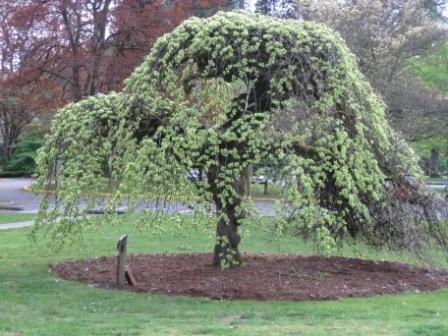A few of you bravely hazarded guesses about this plant, and while it is a contorted specimen, it’s actually Ulmus glabra ‘Camperdownii’, otherwise known as Camperdown elm. Here’s a photo of a lovely example at Marymoor Park near Seattle:

As plant geeks already know, this odd tree was propagated from a mutant branch discovered on the Earl of Camperdown’s estate in Scotland in the 1800s. All Camperdown elms are grown from cuttings originating from this single tree grafted onto a Ulmus spp. rootstock which supplies the straight trunk.
Though these trees don’t get terribly tall, they can become quite broad and need space for their tiers of foliage. Like other contorted trees, the branches of old Camperdown elms can meet and fuse, as you can see in the photo from Friday. And while the tree produces scads of seeds (that’s what you see in the photo above – not leaves!), they are sterile.
Cool tree, no doubt, but “commonly used in landscapes” might be a bit of an overstatement – at least it is in the mid Atlantic states. You west coast people make me jealous 🙂
Sorry, Paul! It is a relatively hardy tree (USDA zone 4). It is not happy without summer irrigation, however, so it does best in managed conditions. Give it a shot!
Va Tech has (had?) a terrific specimen by their library and I think Longwood Gardens has a beautiful one at the base of their hillside garden, but those are the only two I’ve seen.
BTW – did you ever figure out what that mystery desert plant was? The one with the brown buds…
Are they susceptible to disease?